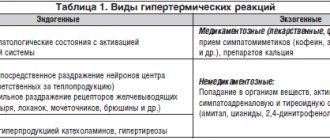Temperature from nerves - professional psychologists and neurologists are not surprised by this phenomenon. After all, the human body reacts sensitively to various processes occurring in the nervous system. You just have to strain yourself a little or overdo it with stress, and the body will respond with an increase in temperature. Clinical psychologist, neuropsychologist Irina Khvingia told AiF.ru about what thermoneurosis is, who is more susceptible to it than others and what consequences it can lead to .
The essence of the problem
There is no official diagnosis of “thermoneurosis” as such. But the phenomenon itself exists. Thermoneurosis is usually understood as a psychosomatic disease when a person experiences an increase in temperature over a long period. The numbers will be low-grade, that is, the temperature will fluctuate between 37-37.5 degrees. This is one of the manifestations of vegetative-vascular dystonia, and some experts even consider this state of affairs to be a sign of depression.
There are two types of thermoneuroses: psychogenic, which occurs against the background of stress, and neurogenic, when the brain is affected by hematomas, cysts and other formations that put pressure on the thermoregulation centers.
Article on the topic
Psychologist instead of antipyretics. How to calculate thermoneurosis?
If we are talking about a tumor, then we will have to be regularly examined and monitored. If the tumor does not grow, people live well with it for many years. In this case, it is usually recommended to undergo an MRI procedure once a year in order to monitor the condition of the formation in detail.
Temperature of a psychogenic nature can be elevated for a long time: from several days to several years. It all depends on who and how helps a person cope with the disorder. If everything is left to chance, the situation can be long-lasting.
We talk about thermoneurosis when the temperature remains unchanged throughout the day and for at least several days. For example, if it always stands at 37.2 or 37.3. To exclude factors influencing temperature and determine a more accurate diagnosis, it is recommended to draw up a temperature chart. Indicators must be measured three times a day. The first time is 20-30 minutes after sleep. There is no need to do it right away, without getting out of bed, because after waking up, everyone’s temperature is slightly elevated. Then measurements are taken during the day without reference to meals. And the third dimension is before bed.
Vegetative-vascular dystonia - a disease or a myth? More details
Thermoregulation in the body
For normal human life it is necessary that heat exchange be carried out constantly. It depends on the characteristics of the organism and on the presence of various reflex stimuli, and changes can have an effect even if the ambient temperature remains unchanged.
Violation of thermoregulation
First of all, such violations can occur as a result of exposure to external or internal factors. For example, internal diseases include various types of diseases.
The main symptoms can be considered:
- chills;
- chills, as a result of hyperkinesis - when involuntary muscle contractions occur;
- as a result of hypothermia - the consequences of hypothermia;
- as a consequence of hyperthermia - in case of overheating of the body.
The main causes of thermoregulation disorders are:
- congenital or acquired defect of the hypothalamus. It can negatively affect the functioning of many internal organs, including body temperature itself;
- climate change. This external factor is capable of influencing body temperature as a result of adaptation of the body;
- alcohol abuse;
- a consequence of processes associated with aging;
- various mental disorders.
Who is susceptible
The psychogenic option is more of a topic for teenagers and older people. After all, the loads are growing. For example, for children this means increased responsibility at school. A large number of classes, additional clubs and sections. Normal overwork occurs, the body cannot stand it and produces such a reaction.
This condition is typical for people with a hysterical personality type, those who are susceptible to hypochondria, suspiciousness, and those who are prone to various types of psychosomatics. Because they are the first to react to stress, and an increase in body temperature is the simplest reaction.
Frequently asked questions
Is it true that if a person has been in a state of nervous tension for a long time, he becomes more susceptible to various diseases? Can a nervous condition lead to illness?
Doctors' observations say that an initially mentally and physically healthy person is able to endure prolonged or severe stress without subsequent complications in the form of illnesses.
But if the body already has its own “weak points” in the form of a predisposition to diseases, disorders in the early (not yet identified) stages, or is weakened by a disease, then overstrain of the nervous system can trigger a whole cascade of ailments. Frequent examples of such developments are the formation of hypertension, weight loss or gain after stressful events.
Is it true that all “diseases are from nerves”?
Many diseases have causes and mechanisms of development in the form of disorders of the nervous system and psyche. But it is not correct to say that “all diseases are from nerves.” There are other causes for diseases: genetic defects, infections and poisonings, injuries, there are many disorders with an undetected etiology.
Can internal diseases cause mental disorders?
Yes. Body and psyche are connected. A significant part of diseases of internal organs can contribute to behavioral disorders and lead to mental illness.
For example, atherosclerosis and hypertension, if left untreated and progressing, will cause encephalopathy and psychoorganic syndrome (decreased memory, intelligence, emotional instability). Insufficiency of the thyroid gland leads to a decrease in intellectual capabilities.
Consequences of the problem
Thermoneurosis, which lasts for a long time, affects human health. And it doesn’t matter whether the body is a child’s or an adult’s. Children, as a rule, become irritable against its background. And adults become exhausted faster. Naturally, all this affects performance, because there is constantly not enough strength. At a constantly elevated temperature, the body requires more strength to concentrate attention and memory.
There are even more serious situations when symptoms such as fainting, arrhythmias, headaches, and sometimes insomnia appear. But still, for the most part, thermoneurosis is asymptomatic, accompanied only by fever and irritability. Against this background, the quality of life significantly decreases.
Temperature record. How to deal with high numbers on a thermometer Read more
What not to do at high temperatures
You should react to an elevated temperature without panic, but with special care.
It is not recommended to bring it down in the first minutes after the increase; you need to let the body cope with the temperature on its own. At this time, the body’s defenses are mobilized and pathogens of various diseases die. But even when lowering the temperature, you should not strive for 36.6. In the first days of illness, this is unlikely to be achieved. Rubbing, especially with vinegar or alcohol solutions, is not recommended. However, this practice still exists at home. If a patient with a high fever is pale and his limbs are cold to the touch (so-called white hyperthermia), then any rubbing is contraindicated for him and, in addition to antipyretics, antispasmodics are recommended. The fact is that cold extremities are caused by vasospasm. And in this case, cold rubbing with vinegar or alcohol-containing liquids can only worsen the situation with the blood vessels.
Wiping with vinegar is not indicated for adults and children with respiratory manifestations of the disease or chronic pathologies of the respiratory system. Vapors can worsen the patient's condition and affect the breathing process. Also, intolerance to vinegar or alcohol, as well as the presence of damage and irritation of the skin, are contraindications to rubbing.
At high temperatures, it is not recommended to eat rich, fatty foods and sugar. An increase in glucose levels in the body reduces the number of white blood cells, which are responsible for destroying infected cells. Which can harm the process of fighting bacteria and viruses. And fatty foods create additional stress on digestion and the body devotes some of its energy to this process, instead of fighting the enemy.
Speaking about drinking liquid at a fever, it should be noted that hot drinking is strictly contraindicated! Especially coffee. Caffeine causes dehydration. A hot drink warms up the body even more. Only warm fruit drinks and herbal teas.
Precautionary measures
In the fight against stress, you need to learn to look at the world around you positively
There is no special prevention to prevent an increase in body temperature during nervous overstrain. However, you can follow certain rules to help reduce the risk of stress and nervous tension, as well as improve your health.
- If you expect a stressful situation to arise, for example, you are about to take an exam, you must first start taking sedatives, for example, Novopassit. To help with upcoming intellectual stress, you can use Aminalon, but it is better to consult your doctor first.
- Moderate physical activity strengthens the autonomic nervous system. It is important that your exercises take place daily, and it is recommended to do light warm-up two to three times a day.
- It is important to take care of strengthening the immune system and learn to maintain a rest and work regime. If you are a workaholic, it's time to give yourself a rest and change your daily routine. It is also important to find time for hobbies, communication with family and friends, walks, and self-improvement.
- Meditation, yoga, and aromatherapy will help prevent stress.
- Control your internal state, calmly react to problems that arise in your life. Try to see the positive even where, at first glance, there is none.
- Isolate yourself from whiners, people who dump their negativity on you.
Now you know that if a temperature appears after a strong or prolonged nervous overstrain, this is a normal phenomenon, the body’s response to the influence of a negative stimulus. It is important to understand that stress in general has a negative effect on the human body, disrupting the functioning of all organs and systems. Take care of yourself, avoid nervous tension.
Reduced body temperature
Like high temperatures, low temperatures also indicate problems. Especially if it lasts for a long time. This leads to rapid fatigue, loss of mood, weakness of the body, etc.
Causes of low body temperature
A decrease in temperature is observed:
- with low hemoglobin;
- in case of internal bleeding;
- during pregnancy;
- if there are problems with blood vessels;
- for diabetes;
- with pathology of the adrenal glands;
- during brain tumors;
- with asthenic syndrome;
- during skin lesions;
- as a result of seasonal ARVI;
- in case of intoxication;
- as a consequence of hypothermia;
- with hypothermia.
Symptoms of low body temperature
Symptoms include:
- weakness;
- drowsiness;
- apathy;
- chills;
- feeling of cold.









